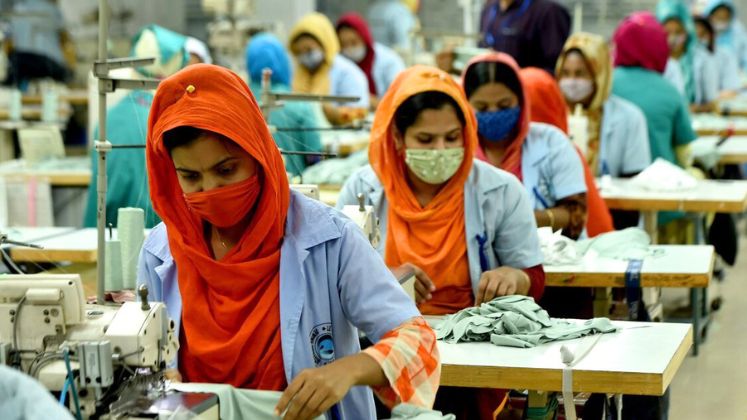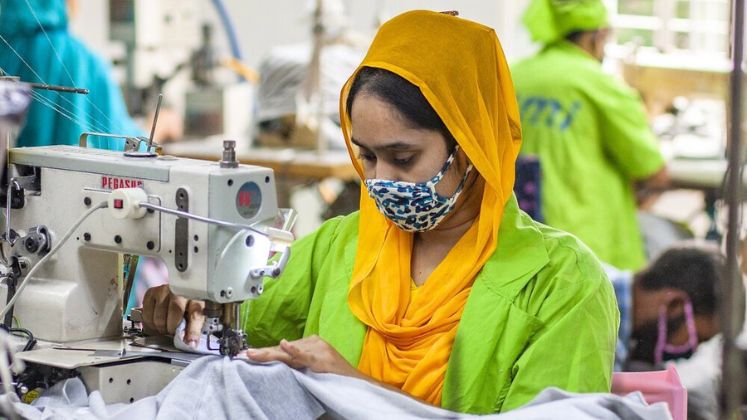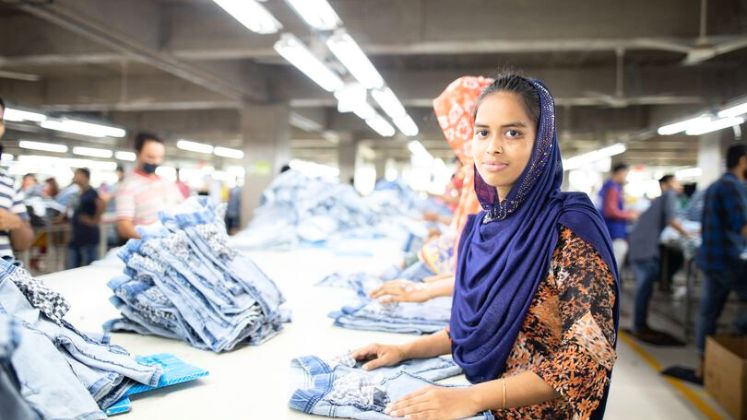Over the past four decades, RMG export industry in Bangladesh has significantly expanded from almost zero to US $ 47 billion, creating substantial formal employment opportunities for women. This growth has not only increased the visibility of women in the labour market but has also contributed to their empowerment within the society. Notably, the garment industry has played a pivotal role in challenging societal restrictions imposed on women in Bangladesh, with thousands commuting to work in Dhaka and Chattogram’s major cities each morning.
However, recent trends indicate a gradual decline in the proportion of women workers in the RMG sector. Unlike the past, where women constituted 80 per cent of the labour force, the latest estimates reveal a decrease to less than -66 per cent till 2022!
This shift carries significant implications for women’s economic empowerment, as well as the overall well-being of their families and communities. While jobs in garment factories traditionally provided financial and future security, there has been a noticeable change, necessitating an exploration of the underlying reasons.
In 2021, 51 per cent of those leaving the RMG sector were women, marking a slight increase from the 49 per cent recorded in 2015. According to a survey conducted by Ethical Trade Initiative in association with GIZ, an overwhelming majority (89 per cent) cited voluntary departure, emphasising that their contracts were not terminated by factory management.
The primary reasons identified for leaving included childcare responsibilities, pregnancy, age-related concerns and challenges in balancing home and work responsibilities. Working conditions, encompassing harassment, violence, long hours and low salaries, also played integral roles in making women choose to exit the sector. Surveyed factory management echoed these findings, with family situations (40 per cent) and working conditions (15 per cent) being key factors influencing female workers’ decisions to leave.
Further investigations into the dearth of female supervisors revealed several factors. Male workers found it challenging to accept female supervisors and male line chiefs struggled to work under women supervisors.
Female workers cited the need to attend to family responsibilities as a barrier to taking on roles requiring long hours. Interestingly, some women workers expressed a reluctance to work under female supervisors, while fixed salaries for supervisors, in contrast to the overtime opportunities for operators, were identified as another factor.
Is RMG still a preferred industry for women?
Although RMG exports contribute nearly 83 per cent to the country’s overall export revenues and women still are the largest chunk in the worker ecosystem of the country’s apparel industry, 46 per cent of potential women workers favour non-garment sectors.
Their job preferences are influenced by factors such as education, location, marital status, number of children, family structure, household income and time available for household work. Reasons for favouring non-garment sector jobs include flexible timings, easier commutes, personal independence in workload management, more understanding supervisors and a lack of verbal abuse.
Amena Urmi, AGM – HR, MBM Group, commented, “The diminishing presence of women in the RMG sector reflects deeper societal challenges. It’s not just about workplace conditions; it’s about the expectations placed on women. We need comprehensive policies that address both workplace issues and the societal norms influencing women’s choices.”
Disparity in the labour wages in RMG industry is said to be another reason why women are not keen on working in apparel manufacturing. According to a survey carried out by SANEM (South Asian Network on Economic Modeling), women workers received Taka 45 against one-hour work compared to that of Taka 48 for a male worker even if female workers worked 267 hours on an average in a month compared to that of 270 hours for a male worker.
Impact on factories!
If one ever visits Bangladeshi RMG factories, he/she can find that majority of skilled workforce is still women – be it in sampling unit, on production floor or in finishing/packaging areas. The factories that have experienced a gradual decrease in their women workforce over a two-year period have been grappling to manage on-time shipment rate.
“Our overall productivity declined by 15 per cent as the factory lost the unique skills that women workers brought to the production line,” mentioned a Production Head of a leading garment manufacturing unit based out of Savar.
15 per cent decline in productivity at a time when order fluctuation is already there is something that has hurt the planning of the factory. There was an increase in the number of defective products (6.28 per cent as compared to standard DHU rate of the company which was 2.97 per cent until 2021), indicating a decline in the quality of the manufactured garments.
The adverse effect is especially seen on mid-scale and small-scale units such as in case of F&B Apparel, Chittagong where employee turnover increased by 22 per cent amongst the remaining women employees, as they felt comfort in other burgeoning industries.
“We have been facing challenges in meeting production deadlines due to a less adaptable and diverse workforce, impacting order fulfilment. We have always tried to ship on time but this season, we missed timelines several times due to less women workers,” mentioned Ali Naser, MD of the company, adding that these women took their expertise and experience with them that resulted in a loss of institutional knowledge that was difficult to replace.
The decrease in women workers has a multifaceted impact on factories, undeniably, affecting productivity, quality, employee morale and market reputation.
Insecurity persists as the use of automation increases!
In the cutting and sewing processes, the number of women workers went down significantly while the number of machines increased. Factory managers report that women workers weren’t interested in automation, however different reports and research show the opposite! Young workers, especially, are eager to embrace technology and learn through observation and hands-on training.
Some women workers believe there’s not enough training on automation and there’s a stereotype that women don’t like using technology. This stereotype is not good for gender equality and women’s empowerment. Many participants were not worried about using technology, but some machines required physical efforts, which managers thought were better suited for male workers. Some education is still needed for tasks like quality checking, but women workers believe their experience made up for a lack of formal education.
While new technologies can be beneficial for factories, they may not be good for jobs. For instance, in a sweater factory, workers said that new machines replaced many jobs and the increased use of technology meant fewer employment opportunities for everyone in the sector. Automation also led to higher workloads and targets for workers. With higher wages and the introduction of automation, workers now have to produce more pieces per day, which is causing problems.
““With the arrival of jacquard machines, we, the sweater factory workers, have been forced into the streets. One of those machines can replace four workers and four machines require only one operator to function,” commented a woman working in a very reputed sweater factory in Bangladesh.
According to McKinsey & Company, suppliers in Bangladesh need to invest in upskilling, digitalisation and automation to stay competitive. Bangladesh is losing its preferential trade agreement with the EU and Vietnam, its main competitor, has signed a new trade agreement with the EU.
“Yes, to stay competitive, there needs to be investment in upskilling, especially for women garment workers, to adapt to automation and new technologies in the sector. As the fashion industry focuses more on environmentally friendly practices, there will likely be more automation in the future. It’s crucial that women workers are not left behind in this shift to cleaner and more efficient production methods,” said Rakibul Islam Khan, MD, Pakiza Knits Composite Limited.
Recommendations and solutions to address the issue
Expressing concern about the potential impact of automation on various occupations, Osama Taseer, President of the Dhaka Chamber of Commerce and Industry (DCCI), advocates for proactive measures.
“There should be a focus on reskilling and upskilling the women workforce, emphasising areas such as big data analytics, drone and robot operations, large sorting and planting machine operations, mechanical engineering, artificial intelligence network expertise, technology-driven services, computer-aided processes and enterprise resources planning. This forward-thinking approach aims to prepare the women workforce for the future, ensuring adaptability in the face of evolving technological landscapes,” averred Osama.
To address the declining number of women workers in the RMG industry, the factories are taking every step necessary. Some factories are educating managers and workers about gender equality and promoting a culture of respect and inclusion that can help create a healthy work environment free from harassment and violence. Many factories including Laila Group, MBM Group etc., have already established creche and are further increasing such facilities as it is believed women workers are leaving the industry mainly because they have to take care of their children, as mentioned earlier.









